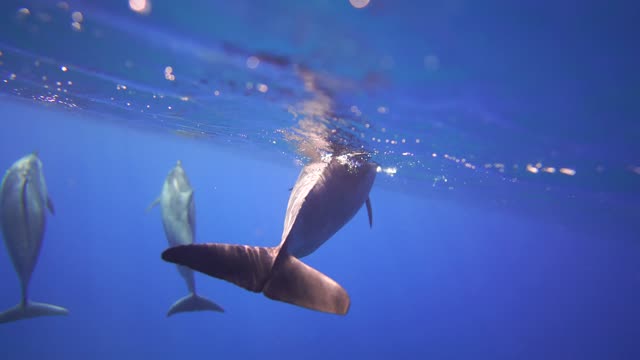Premium Only Content

Dolphin swimming
Dolphin swimming
Dolphin is the common name of aquatic mammals within the infraorder Cetacea. The term dolphin usually refers to the extant families Delphinidae (the oceanic dolphins), Platanistidae (the Indian river dolphins), named Iniidae (the New World river dolphins), and Pontoporiidae (the brackish dolphins), and the extinct Lipotidae (baiji or Chinese river dolphin). There are 40 extant species named dolphins.
Dolphins range in size from the relatively small 1.7-metre-long (5 ft 7 in) long and 50-kilogram (110-pound) bodied Maui's dolphin to the 9.5 m (31 ft 2 in) and 10-tonne (11-short-ton) killer whale. Dolphins can sometimes leap about 30 feet (9.1 m). Several species of dolphins exhibit sexual dimorphism, in that the males are larger than females. They have streamlined bodies and two limbs that are modified into flippers. Though not quite as flexible as seals, some dolphins can travel at speeds 29 kilometers (18 mi) per hour for short distances.[1] Dolphins use their conical-shaped teeth to capture fast-moving prey. They have well-developed hearing which is adapted for both air and water and is so well developed that some can survive even if they are blind. Some species are well adapted for diving to great depths. They have a layer of fat, or blubber, under the skin to keep warm in the cold water.
Although dolphins are widespread, most species of them prefer the warmer waters of the tropic zones, but some, like the right whale dolphin, prefer colder climates. Dolphins feed largely on fish and squid, but a few, like the killer whale, feed on large mammals, like seals. Male dolphins typically mate with multiple females every year, but females only mate every two to three years. Calves are typically born in the spring and summer months and females bear all the responsibility for raising them. Mothers of some species fast and nurse their young for a relatively long period of time. Dolphins produce a variety of vocalizations, usually in the form of clicks and whistles.
Dolphins are sometimes hunted in places such as Japan, in an activity known as dolphin drive hunting. Besides drive hunting, they also face threats from bycatch, habitat loss, and marine pollution. Dolphins have been depicted in various cultures worldwide. Dolphins occasionally feature in literature and film, as in the film series Free Willy. Dolphins are sometimes kept in captivity and trained to perform tricks. The most common dolphin species in captivity is the bottlenose dolphin, while there are around 60 killer whales in captivity.
-
 2:13
2:13
AnthonyCayman1
4 years agoSwimming with Dolphin (live)
30 -
 2:43
2:43
AnthonyCayman1
4 years agoSwimming with the Dolphin
107 -
 3:15
3:15
Xkwahid
4 years ago $0.80 earnedDolphin swimming kids thinks its a Shark😂😂😂
1.47K -
 0:55
0:55
bestfunnytv1
4 years ago $0.05 earneddolphin swimming on the sea
74 -
 0:58
0:58
bestfunnytv1
4 years ago $0.01 earnedso beautiful dolphin swimming in esa
29 -
 4:27:48
4:27:48
ThePope_Live
6 hours agoLIVE - First time playing The Finals in over a YEAR! Still good? with @Arrowthorn
30.7K1 -
 3:06:26
3:06:26
TruthStream with Joe and Scott
12 hours agoRoundtable with Patriot Underground and News Treason Live 4/26 5pm pacific 8pm Eastern
50.9K34 -
 8:52
8:52
Tundra Tactical
10 hours ago $9.72 earnedSCOTUS Denies Appeal, Minnesota Courts Deal 2a Win!
51.7K11 -
 10:36:01
10:36:01
a12cat34dog
12 hours agoONE WITH THE DARK & SHADOWS :: The Elder Scrolls IV: Oblivion Remastered :: FIRST-TIME PLAYING {18+}
71.3K5 -
 22:27
22:27
Exploring With Nug
19 hours ago $12.83 earnedSwamp Yields a Chilling Discovery in 40-Year Search for Missing Man!
64.5K17